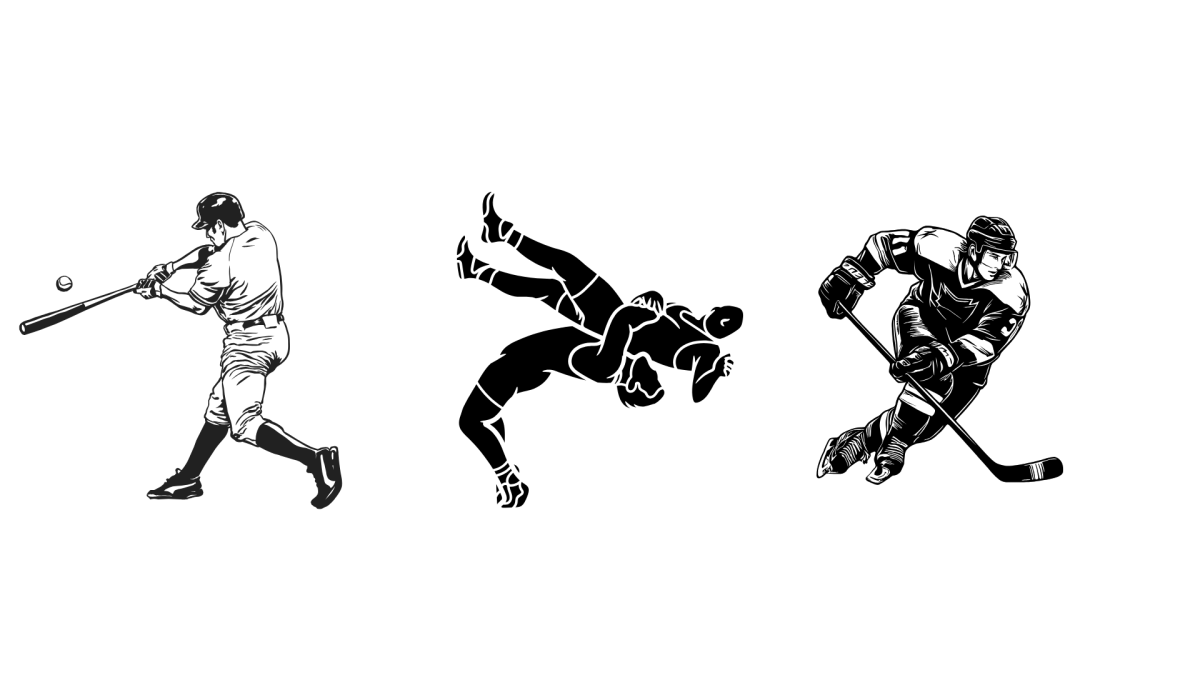As a high school student and baseball player, I’ve had a front-row seat to what it takes to play one of the hardest sports there is. From grinding out doubleheaders in the sun to dealing with the mental strain of a hitting slump, baseball demands more than most people realize.
But the deeper I’ve looked into the demands of other sports, the more confident I am in saying this: baseball, wrestling, and hockey are the three most difficult sports an athlete can play. Each of them challenges players in ways that go far beyond physical strength or talent — they demand mental toughness, relentless discipline, and a commitment to perfection that most sports don’t.
Let’s start with baseball — the one I know best. I play outfield, which means I’m constantly reading the ball off the bat, calculating my route to get to it, and making split-second decisions. There’s no room for hesitation.
One false step can turn an out into a double. Every movement is precise. Every throw needs to be accurate. And even though we’re not in every single play, when the ball does come our way, we have to be perfect. That pressure builds up over time.
Baseball is often misunderstood. From the stands, it can look slow, almost like it lacks intensity compared to faster-paced sports. But anyone who plays it knows that baseball is a constant mental battle. You’re fighting pressure in every at-bat, every pitch, and every inning. Success is rare, and failure is constant — it’s the only sport where failing 7 out of 10 times makes you elite.
That alone makes it brutal.
“People don’t see how much thinking goes into it,” Braden Christlieb, one of the team’s catchers, said. “I’m tracking hitters’ tendencies, communicating with the pitcher, and trying to keep the umpire happy with how I frame pitches. And that’s before I even think about hitting.”
Braden’s right. Baseball is an intellectual game. It’s about studying your opponents, adjusting constantly, and staying mentally locked in through hours of play.
Even for outfielders like me, we’re always adjusting our positioning based on who’s hitting, the count, the wind, and how the pitcher is throwing. You’re never just standing there — you’re calculating.
And don’t forget the grind of the season. Baseball seasons are long — we’re talking months of games, often several a week, plus weekend tournaments, early morning practices, and off-season travel ball. Even high school players barely get a break. By the time the spring season ends, summer ball starts. There’s barely any off-season, and that wears on you.
Tommy O’Connor, the teams other catcher, said how the physical toll adds up.
“I’m squatting hundreds of times a game, taking foul tips off my chest, blocking balls in the dirt, and then still expected to come up and hit,” he said. “And if I mess up a throw or a call, it could cost us a run or even the game. That pressure’s always there.”
Tommy’s right. The game is unforgiving. Whether you’re a catcher, a pitcher, or an outfielder like me, every mistake is magnified. Baseball is slow only on the surface — underneath, it’s a storm of decisions and consequences.
Jaxon Craker, one of the team’s pitchers. Pitchers carry an enormous load. They set the tone for the game, and all eyes are on them. One bad pitch can turn a close game into a blowout.
“It’s all about control,” Craker said. “You’ve got to hit your spots, mix your pitches, and stay calm when the count’s full or runners are on base. One pitch can change everything.”
Pitching is one of the most difficult skills in all of sports. It’s a violent, unnatural motion that puts incredible strain on the arm and shoulder. And it requires extreme finesse — you’re trying to locate a baseball within a tiny window over and over, all while facing hitters who have studied your every move. Pitchers have to outthink, outwork, and outlast everyone else.
But baseball isn’t alone in its difficulty.
Wrestling might be the most physically and mentally demanding sport on the planet. It’s one-on-one, no teammates to help you, and no time to rest. You’re fighting for every point with your whole body. Wrestlers are among the most conditioned athletes — they train for explosiveness, balance, flexibility, and power.
Wrestling is pain. It’s holding someone off while your lungs are on fire, while your muscles are shaking, and still thinking about how to score. It’s the hardest thing I’ve ever done, but also the most rewarding.
And that’s before you get into the weight cutting. Wrestlers often drop weight quickly to fit into certain classes, and while that’s controversial, it shows the kind of mental discipline the sport demands.
You can’t afford to slip — not in your training, your diet, or your mindset. Matches are fast, intense, and often come down to a single move. That kind of pressure changes you.
Wrestling also teaches something few other sports do: how to lose. In a sport where only one person wins, you lose a lot. Wrestlers have to learn to handle that — to take it, learn from it, and come back better. That kind of resilience is something every athlete should learn.
“It’s like trying to play soccer on ice while people are trying to hit you full speed,” Cracked Sid. “You need legs like tree trunks, insane balance, and still soft hands to pass and shoot.”
Hockey is one of the most chaotic, high-speed sports out there. Skating alone is a skill that takes years to master. Now add in the stickhandling, the need for constant communication, the nonstop action, and the physicality — and you’ve got a sport that demands everything from its players.
Hockey players take hits that would sideline athletes in other sports, and just keep playing. The bruises, the injuries, the cold — it’s all part of the game. And like wrestling and baseball, hockey doesn’t give players much of a break. Travel, tournaments, early mornings — it’s a year-round commitment.
It also requires versatility. Forwards need to score, but also get back on defense. Defensemen need to block shots and still carry the puck up ice. Goalies, perhaps more than anyone, are under constant pressure. One mistake could mean the loss. It’s nonstop action and nonstop tension.
When you step back and compare these three sports — baseball, wrestling, and hockey — it’s clear that each of them is difficult in its own way. Baseball is a slow burn — a game of detail, mental strength, and relentless repetition. Wrestling is raw intensity — pure one-on-one battle, demanding maximum physical and mental endurance. Hockey is fast and violent — an explosion of speed, contact, and control.
The reason I believe these three stand out from the rest is because of what they demand over time. Some sports are hard in the moment — football hits, basketball sprints — but they give you more breaks. In baseball, wrestling, and hockey, the grind never ends.
Every practice, every game, every off-season workout adds up. You don’t get a break mentally or physically. You’re always trying to improve, always dealing with failure, always getting tested.
What these sports teach you is how to handle adversity. Baseball teaches you patience. Wrestling teaches you perseverance. Hockey teaches you toughness. They all teach you how to stay focused under pressure — how to keep pushing when everything hurts, when things aren’t going your way, and when no one’s watching.
In the end, what makes a sport truly difficult isn’t just how hard it looks — it’s how hard it is to be good at it. And getting good at baseball, wrestling, or hockey? That takes years. That takes heart. That takes something special.
So if you ask me which sports are the most difficult, I won’t hesitate: baseball, wrestling, and hockey. Not because they’re flashy or popular. But because they test every part of you — mind, body, and soul.
While I believe baseball, wrestling, and hockey are the top three most difficult sports, gymnastics absolutely deserves an honorable mention. Gymnasts train their bodies to an almost superhuman level of control, strength, and flexibility. Every routine requires flawless execution — one tiny slip can result in a fall, injury, or a major deduction in score.
The mental pressure is enormous because everything hinges on perfection. Gymnasts don’t get second chances mid-routine — they train for years to land a single vault, beam routine, or floor pass.
The physical demands are unlike anything else. Upper body and core strength, spatial awareness, timing — it all has to be dialed in with extreme precision. And like wrestling and hockey, gymnastics seasons are long, with intense year-round training schedules. Even though it didn’t crack my top three, I have massive respect for gymnasts and what they go through to reach elite levels.






